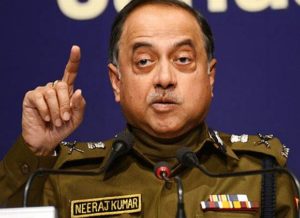A tribute to brave Nirbhaya

We bring an exclusive extract from Night of Shame, one of the nine cases that the former Delhi police commissioner Neeraj Kumar has penned in his second book, Khaki Files – Inside Stories of Police Investigations (Blue Salt, an imprint of Penguin Random House; Rs 399) in which he writes about the Nirbhaya gangrape-murder that shook the nation on December 16, 2012. Kumar was at the helm of affairs of the Delhi Police when this unfortunate incident happened. Read on…
Some incidents and cases are watershed moments in the history of not only a police force, but also the city where they occur and possibly even the country. The anti-Sikh riots in Delhi, the terror attack on the Parliament House and the 26/11 terrorist strikes in Mumbai are such cases. The Nirbhaya case, as the brutal Munirka bus rape case is commonly referred to, was another such tipping point. It galvanised public opinion on the issue of crimes against women and the laws to deal with them not only in India, but worldwide. We in India did well to rise to the occasion and amend our laws drastically by introducing the Criminal Law (Amendment) Act, 2013, amending the Indian Penal Code, Evidence Act and Code of Criminal Procedure with respect to sexual offences. For the first time, offences such as sexual harassment, voyeurism, acid attacks and stalking were expressly recognised and criminalised.
Following these developments, there is empirical data to show that more women are coming forward to report sexual offences committed against them. The most welcome change is that women in India are finding their voice following the Nirbhaya case. They talk about their daily travails in dealing with men, both in public and private spaces, and come forward to report crimes. A cynical view persists in some quarters, though, that nothing has changed after the bus rape case of 2012.
The Nirbhaya case led to an outcry that changed our laws and made them stronger with respect to crimes against women. The focus of the public wrath was the criminal justice system, and particularly the police. Pitched battles were fought between the protestors and the police in which several on both sides were injured and one policeman even lost his life.
In over 96 per cent of rape cases and crimes against women the perpetrators are known to the victims.* Most crimes of this nature are committed within the four walls of homes or offices, by close relatives, colleagues and friends. Should we not pause and ponder if blaming the government or the police for these crimes is the most sensible thing to do? Doesn’t the cure for this malaise lie elsewhere? Will endless police-bashing help the situation in any meaningful way?
Undoubtedly, those were trying times for the Delhi Police in general and for me in particular. But this cannot possibly be compared to the trauma and tragedy that the victim and her family suffered. The public outcry was natural, but regrettably, the situation got politicised and lumpenised, as such cases always do. As far as the police response was concerned, at the end of it all, we emerged stronger and wiser. This case was yet another befitting example of how the Delhi Police can stand up to challenges competently and promptly.
At a personal level, I feel privileged to have been at the helm of affairs in the Delhi Police and to have led my force during such adverse circumstances. That I succeeded in keeping the investigation team insulated from the wrath of the media by taking the brunt of the attack myself—running the risk of being made a scapegoat and being thrown out in disgrace at any moment—was a matter of great professional and personal gratification. The exemplary manner in which officers measured up to the challenges of this case, on both the investigation and law and order fronts, was equally heartening. Filing of the charge sheet in 10 days of the incident, the piecing together and marshaling of physical and scientific evidence, effective prosecution in the courts of law and getting the accused convicted were extraordinary achievements by the force. They did so in the face of two judicial inquiries, hostile public opinion, bad press and several PILs filed in superior courts. They went about performing their work with equanimity and courage that kept my head held high and proud.
Finally, it must be acknowledged that the Government of India and the lieutenant governor were steadfast in their support of the police. They stood by us like a rock, and this prevented our morale from waning. The then Congress president and the prime minister met groups of protestors at their residences, even after midnight, to pacify them. Such support from a government in power for its police, in the face of adverse media and public sentiment, is commendable and exemplary.
At the end of it all, this story is first a tribute to brave Nirbhaya, whose promising life was cut short in a barbaric manner. We do not know to what extent we have succeeded in getting her justice. Perhaps history will give the final verdict in this matter several decades down the line.
Equally, this story is a salutation to Head Constable Subhash Tomar, who lost his life in the line of duty at the hands of unruly elements at India Gate on the evening of 23 December 2012. Last but not the least, no amount of words can ever express my appreciation and gratitude for the officers of the Delhi Police, who stood by me in those trying times and delivered what was expected of them brilliantly.
As I now reflect on the case and the testing aftermath I faced, I am reminded of the words of the American author and publisher Orison Swett Marden. The Success magazine founder Marden said: ‘Success is not measured by what you accomplish, but by the opposition you have encountered, and the courage with which you have maintained the struggle against overwhelming odds.’
Indeed, his words have held true for me throughout my policing career, as they did in this case.


